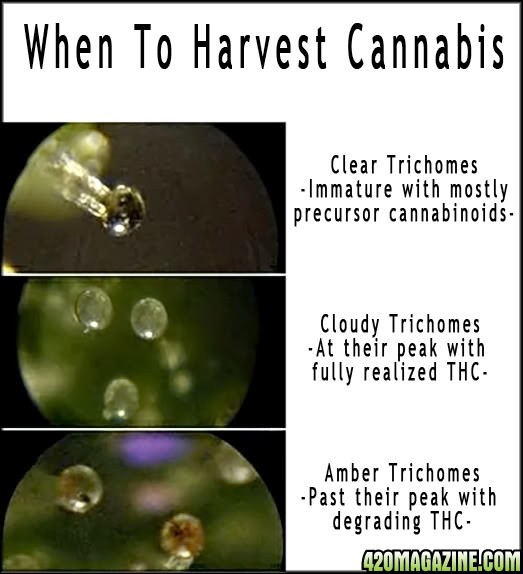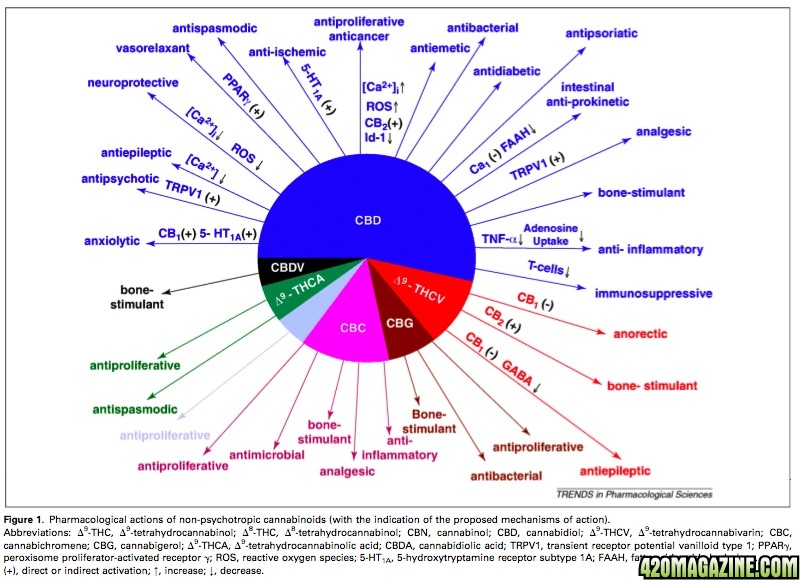I found this article on Weed Portal in the Harvesting and Flushing questions and thought I would post it here:
Cloudy or amber? trics.. when to actually harvest..
Harvesting your weed based on trichomes is probably the easiest way for most growers to harvest as close to peak harvest as possible.
The difficulty in the method comes with how to determine the state of the trichomes and what each state means.
If you have the equipment needed it is however very easy and with experience it gets even easier.
To explain how to harvest by trichomes properly I will go into detail as to how to determine when trichomes are at their peak and which substances these trichomes contain, which are desirable and which are not.
The first thing you need to know is that there are 3 "states" in a trichomes development.
The first state is clear. Clear trichomes contain precursor cannabinoids (cannabinoids are the different substances in cannabis).
These precursor cannabinoids are not psychoactive (they do not produce a 'high') yet and harvesting clear trichomes will not give you a proper harvest.
The second state is cloudy/milky. Cloudy trichomes contain fully realized THC (the by far main contributing substance in any cannabis high).
You want to get as close to 100% cloudy trichomes @ harvest to get the most potency out of your plant. It's impossible to get 100% cloudy trichomes, since trichomes are always being produced and are always maturing, even after harvest the trichomes will continue to develop.
The third state is amber. Amber trichomes contain degraded THC --> CBN. CBN represents a loss of 90% potency (from THC).
CBN is not desirable in any harvest, since it not only represents a huge loss of potency but research into the substance has also shown that CBN does not produce a high like THC does, CBN produces a more sickly feeling not a true high.
Understanding the difference between clear - cloudy - amber trichomes is essential in getting a proper harvest with a peak potency.
This image is a good helper to remember the differences:

To understand how substances change and are developed in cannabis you will need to read extensively on each substance to understand what each substance does and how they affect each other.
This image is helpful in getting a vague knowledge of substances in cannabis and how they develop:

I will not go deeper into what each substance (CBG, CBD, CBC, CBN, THCV etc.) do, suffice to say they all play a part in the cannabis high, albeit a minor part for most of them, since THC is the main factor in a cannabis high.
Some provide pain relief, some reduce muscle spasm, the list goes on and research is still being done to figure out all of the benefits of these substances.
I can however post an image that explains rather well which effects the substances have on the human body:

Trichomes are of course not the only indicator of when to harvest.
There are other factors that should be taken into account when determining when to harvest.
Calyxes on the plant will swell up, these swollen calyxes are a sign of maturity.
The pistils (what some new growers call hairs) will change colour (often to an orange tinge) and recede into the calyx.
Receding pistils are also a sign of maturity.
Then there is the overall look of the plant. Many experienced growers simply go by this factor, they can determine peak harvest just by looking at the plant and seeing how it looks from afar regarding colour tinge and the look of the calyxes.
All these factors should be taken into account when harvesting. All of these factors usually align when peak harvest approaches.
The best way to check how the trichomes on your plant are doing is by means of a loupe or a microscope.
I would recommend getting ones that can at least go to 60x magnification.
Getting one that can go to 100x would be even better, but the more magnification the more cost.
All you have to do is take a small sample of a leaf with trichomes on it, or if you have a loupe or a USB microscope simply look at the trichomes on the plant to determine their 'state'.
It's important that you check all over the plant, since trichomes will usually develop and produce faster at the top(s) of branches and slower and the bottom of the plant.
Some people choose to harvest the tops first and let the bottom nugs grow a bit more to let the trichomes mature and develop further but also to let the buds fatten up more. It's a judgement and preference call really.
It's almost impossible to harvest without at least some amber trichomes (and some clear), keeping the amber trichomes to the minimum is key if you want maximum potency out of your plant.
Usually if you are careful and watchful you will end up with around 5% clear trichomes, 10% amber and 85% cloudy trichomes.
That is a very reasonable % split and is what you should be aiming for.
This info was written by someone else.. i just found it interesting and thought i would share it...
Cloudy or amber? trics.. when to actually harvest..
Harvesting your weed based on trichomes is probably the easiest way for most growers to harvest as close to peak harvest as possible.
The difficulty in the method comes with how to determine the state of the trichomes and what each state means.
If you have the equipment needed it is however very easy and with experience it gets even easier.
To explain how to harvest by trichomes properly I will go into detail as to how to determine when trichomes are at their peak and which substances these trichomes contain, which are desirable and which are not.
The first thing you need to know is that there are 3 "states" in a trichomes development.
The first state is clear. Clear trichomes contain precursor cannabinoids (cannabinoids are the different substances in cannabis).
These precursor cannabinoids are not psychoactive (they do not produce a 'high') yet and harvesting clear trichomes will not give you a proper harvest.
The second state is cloudy/milky. Cloudy trichomes contain fully realized THC (the by far main contributing substance in any cannabis high).
You want to get as close to 100% cloudy trichomes @ harvest to get the most potency out of your plant. It's impossible to get 100% cloudy trichomes, since trichomes are always being produced and are always maturing, even after harvest the trichomes will continue to develop.
The third state is amber. Amber trichomes contain degraded THC --> CBN. CBN represents a loss of 90% potency (from THC).
CBN is not desirable in any harvest, since it not only represents a huge loss of potency but research into the substance has also shown that CBN does not produce a high like THC does, CBN produces a more sickly feeling not a true high.
Understanding the difference between clear - cloudy - amber trichomes is essential in getting a proper harvest with a peak potency.
This image is a good helper to remember the differences:

To understand how substances change and are developed in cannabis you will need to read extensively on each substance to understand what each substance does and how they affect each other.
This image is helpful in getting a vague knowledge of substances in cannabis and how they develop:

I will not go deeper into what each substance (CBG, CBD, CBC, CBN, THCV etc.) do, suffice to say they all play a part in the cannabis high, albeit a minor part for most of them, since THC is the main factor in a cannabis high.
Some provide pain relief, some reduce muscle spasm, the list goes on and research is still being done to figure out all of the benefits of these substances.
I can however post an image that explains rather well which effects the substances have on the human body:

Trichomes are of course not the only indicator of when to harvest.
There are other factors that should be taken into account when determining when to harvest.
Calyxes on the plant will swell up, these swollen calyxes are a sign of maturity.
The pistils (what some new growers call hairs) will change colour (often to an orange tinge) and recede into the calyx.
Receding pistils are also a sign of maturity.
Then there is the overall look of the plant. Many experienced growers simply go by this factor, they can determine peak harvest just by looking at the plant and seeing how it looks from afar regarding colour tinge and the look of the calyxes.
All these factors should be taken into account when harvesting. All of these factors usually align when peak harvest approaches.
The best way to check how the trichomes on your plant are doing is by means of a loupe or a microscope.
I would recommend getting ones that can at least go to 60x magnification.
Getting one that can go to 100x would be even better, but the more magnification the more cost.
All you have to do is take a small sample of a leaf with trichomes on it, or if you have a loupe or a USB microscope simply look at the trichomes on the plant to determine their 'state'.
It's important that you check all over the plant, since trichomes will usually develop and produce faster at the top(s) of branches and slower and the bottom of the plant.
Some people choose to harvest the tops first and let the bottom nugs grow a bit more to let the trichomes mature and develop further but also to let the buds fatten up more. It's a judgement and preference call really.
It's almost impossible to harvest without at least some amber trichomes (and some clear), keeping the amber trichomes to the minimum is key if you want maximum potency out of your plant.
Usually if you are careful and watchful you will end up with around 5% clear trichomes, 10% amber and 85% cloudy trichomes.
That is a very reasonable % split and is what you should be aiming for.
This info was written by someone else.. i just found it interesting and thought i would share it...



